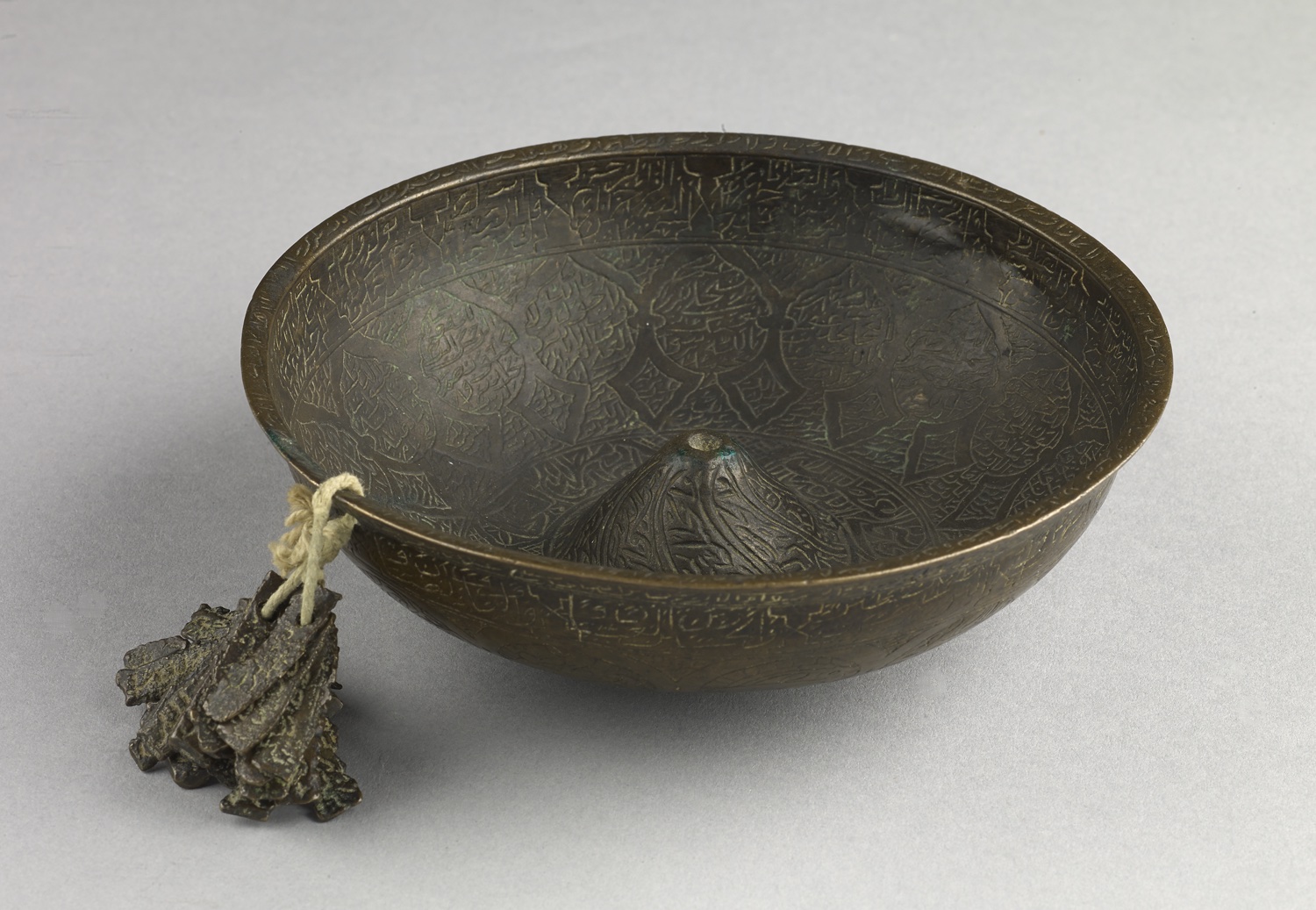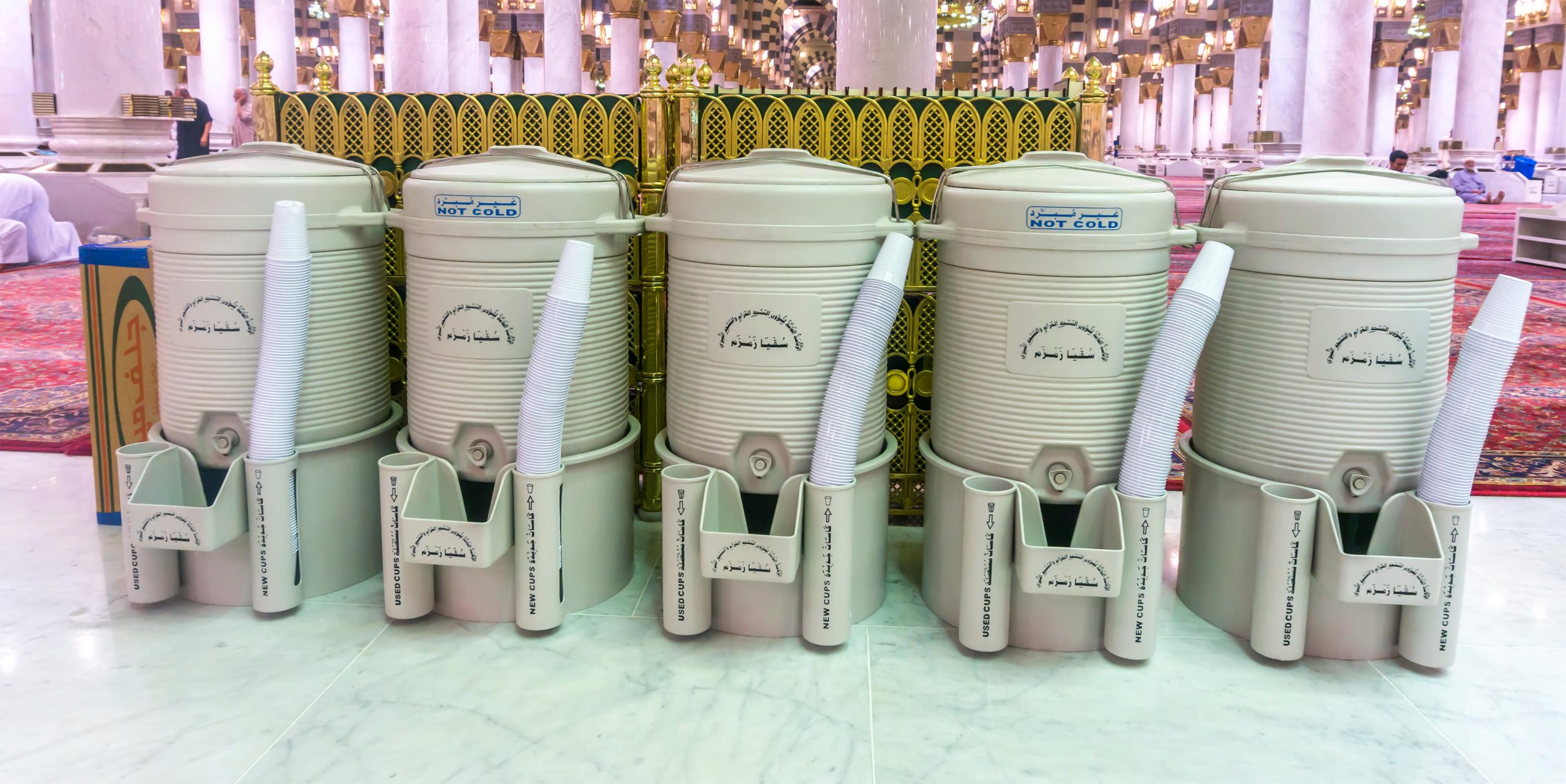This is the second of a three-part series on arts associated with protection and healing in Islam by Professor Christiane Gruber. Throughout the history of Islamic societies, ordinary objects have become vessels for connecting with the divine and seeking protection in trying circumstances. Just as in the present, when people around the world seek comfort in homemade remedies to alleviate their fear of the pandemic, historically during times of plague, amulets, blessed water, and even talismanic shirts have been drawn on for safety and healing.
Christiane Gruber is Professor and Chair in the History of Art Department at the University of Michigan, Ann Arbor; President-Elect of the Historians of Islamic Art Association; and Founding Director of Khamseen: Islamic Art History Online. Her fields of interest include Islamic ascension texts and images, depictions of the Prophet Muhammad, book arts, amulets and talismans, codicology, paleography, architecture, and visual and material culture from the medieval period to today. Her latest publications are her third monograph The Praiseworthy One: The Prophet Muhammad in Islamic Texts and Images (2019) and her edited volume The Image Debate: Figural Representation in Islam and Across the World (2019).
***
Incubating Words: Healing Bowls
Water is of paramount importance in Islamic traditions. Besides its close connection to cleaning and healing, water is praised as the source of all creation, per the Qur’anic dictum: “And We made from water every living thing” (21:30). Water’s centrality coupled with the belief in the potency of inscribed words can be found in a major sphere of Islamic artistic production: namely, healing bowls (also known as “magico-medicinal” bowls). Typically made of bronze or brass, these vessels were used for tending to the sick and divining the future, and hence belong to the realm of the curative and occult arts. They often include incised Qur’anic verses, magic squares, numerical formulas, and astrological imagery. The clear water that they held was believed therapeutic thanks to the incubation of the sacred words or magic spells incised into the body of the object. Indeed, much like paper philters, in which the written words’ ink runoff could be used as a healing potion, the bowls’ liquiform script often was thought to hold the key to the unknown.
At times, such bowls are ornamented with a string of metal tags inscribed with invocations (Figures 7-8). These tiny tablets—known as the “forty keys” (Persian, chihil kilid; Turkish, kırk anahtar)—most often include the bismillah, prayer formulas, and the beautiful names of God. It is believed that these tablets function like prayer beads (tasbih). Similar to a rosary, the tags could provide an opportunity for an individual to thumb through the diminutive plaques while uttering pious litanies—an instance in which the oral tradition of calling upon and praising the divine (dhikr) becomes reified in material terms. Moreover, a folk-doctor could incant healing formulas while “rattling” the rosary, thereby adding a sonorous dimension to the performance of ritual libations.


A number of these bowls include inscriptions pointing to the specific purpose for their production and thus hint to their special properties. For example, some provide protection against poison, the bite of a snake or dog, and the sting of scorpion, much like amuletic scrolls (see figure 5 in the first essay), while others offer a balm against fever, colic, headaches, nosebleeds, intestinal problems, and birth pains. Still others are said to relieve pain of heart, the evil eye, and plagues. In times of epidemic outbreak, the sanitizing potential of baraka-infused water was thought to counteract waba’, a term meaning both “corruption of the natural environment” and “epidemic disease.”
During the first half of the twentieth century, healing bowls were linked most especially to female fertility and childbirth. Writing in 1938, Bess Allen Donaldson reported on such practices while conducting fieldwork in Iran, noting that women desiring children wore charms, lockets, and bangles. She goes on: “A woman who desires a child will take with her to the bath a copper or brass bowl, to which are fasted forty keys. She fills this forty times and empties it each time over her head” (Donaldson, 24). In addition to fertility rites in bathhouses, Donaldson notes that forty-key bowls also were used to wash forty-day-old babies in order to protect them from the evil spirits or jinn, while the number forty is itself important as it marks the day a deceased person’s spirit returns (Donaldson, 35 and 110).
Beyond such healing bowls, the sacrality of water is best embodied by the Zamzam well in Mecca, to which Muslim pilgrims flock in order to fill flasks with the holy liquid (Figure 9). Thought to bear curative properties, this water was, and still is, imbibed directly or mixed into other liquids to create therapeutic potions.

Breaching well beyond elite spheres, the popularity of Zamzam water has led to the mass production of plastic bottles that are readily available for sale today, including on Amazon (Figure 10). In earlier centuries, however, water was stored in more rare and expensive glass vessels and ceramic jugs known as Zamzamiyyas. Water also has been used for Islamic ritual ablutions for over a millennium, and hence various basins—like some Chinese blue-and-white porcelains that are inscribed with the well-chosen word “purity” (taharat)—encourage believers to cultivate both spiritual and physical cleanliness (Figure 11).


The incentives of hand washing and proper hygiene remain as timely as ever (Figure 12). Today, these types of behaviors, especially the washing of hands with soap, form a central part of public health efforts. Additionally, they are tied to scientific and medical discourses about the characteristics and modalities of infectious diseases as well as how best to curb their spread.

In the premodern period, preventative actions and salutary objects engaged with other discourses. In more spiritual registers, protective practices and objects were praised for their ability to help secure goodness, an effort encompassed by the Arabic term istikhara. Meaning “asking God to guide or help one make the best possible choice” or “embark on a propitious course of action,” istikhara most often was sought in the Qur’an’s “secret” signs, including its verses and their special characteristics. However, at times individuals also believed that protection could be secured from prophylactic artifacts such as amulets, bowls, and bottles. That such items are mass-produced and offered for sale still now, in our “COVID era,” attests to the strength and durability of the widespread human desire to “secure good” through a range of efforts and objects—a desideratum that individuals may conceptualize as not mutually exclusive of believing in the safety and effectiveness of a vaccine.
Whether couched as religion or medicine—a dyad that has a complicated history of its own—the arts of protection and healing engage with notions of the divine as well as concerns about hygiene. For some, these two fields may intersect; for others, they do not. Common threads nevertheless do emerge, and these include, above all, the importance of maintaining proper hygiene and “securing good” through practices and objects that are deemed effective and acceptable by their respective communities of care.
Further Reading:
Bates, Ülkü. “The Use of Calligraphy on Three-Dimensional Objects: The Case for ‘Magic’ Bowls,” in Brocade of the Pen: The Art of Islamic Writing, ed. Carrol Garrett Fisher, 55-61, East Lansing, Kresge Art Museum, Michigan State University, 1991.
Conrad, Lawrence, “Ta‘un and Waba’: Conceptions of Plague and Pestilence in Early Islam,” Journal of the Social and Economic History of the Orient 25/3 (1982), 268-307.
Donaldson, Bess Allen. The Wild Rue: A Study of Magic and Folklore in Iran, 24, London, Luzac, 1938.
Donaldson, Bess Allen. “The Koran as Magic,” The Muslim World 27 (1937), 254-266.
Flood, Finbarr Barry. “Bodies and Becoming: Mimesis, Mediation, and the Ingestion of the Sacred in Christianity and Islam,” in Sensational Religion: Sensory Cultures in Material Practice, ed. Sally Promey, 459-493, New Haven and London, Yale University Press, 2014.
Ittig, Annette. “A Talismanic Bowl,” Annales Islamologiques 18 (1982), 79-94.
Perk, Halûk and İsmail Günay Paksoy, Duanın Sudaki Gizemi Şifa Tasları, Istanbul, Zeytinburnu Belediyesi, Halûk Perk Müzesi, 2011.
Porter, Venetia. “Gifts, Souvenirs, and the Hajj,” in Hajj: Global Interactions Through Pilgrimage, ed. Luitgard Mols and Marjo Buitelaar, 95-111, Leiden, Sidestone Press, 2015.
Savage-Smith, Emilie et al, Science, Tools & Magic (The Nasser D. Khalili Collection of Islamic Art), part 1, 72-97 (on magico-medicinal bowls), London, Nour Foundation in association with Azimuth Editions and Oxford University Press, 1997.
Silverman, Raymond. “Drinking the Word of God,” in Inscribing Meaning: Writing and Graphic Systems in African Art, ed. Christine Mullen Kreamer and Sarah Adams, 11-17, Washington, DC: Smithsonian, National Museum of African Art, 2007.
Spoer, H. Henry. “Arab Magic Medicinal Bowls,” Journal of the American Oriental Society 55/1 (1935), 237-256.
Stearns, Justin. Infectious Ideas: Contagion in Premodern Islamic and Christian Thought in the Western Mediterranean, Baltimore, Johns Hopkins University Press, 2011.
Varlık, Nükhet, ed. Plague and Contagion in the Islamic Mediterranean, Newark, Arc Humanities Press, 2017.
Zadeh, Travis. “Touching and Ingesting: Early Debates over the Material Qur’an,” Journal of the American Oriental Society 129/3 (2009), 443-466.











